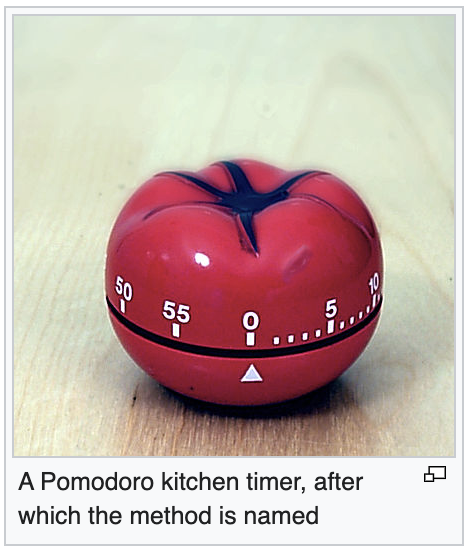Introduction
Do you: find little distractions that often derail your whole work day, work beyond your optimal productivity, become inappropriately optimistic when it comes to how much you can do in a day, have a sizable amount of open-ended work that might take unlimited amounts of time, enjoy goal setting as a game? If any of these things apply to you, there is a popular time management method that may help you achieve focus, power through distractions and be extremely productive. It is called the Pomodoro Technique.
What is The Pomodoro Technique?

The Pomodoro Technique had its roots in the late 1980s. A university student at the time, Francesco Cirillo was struggling to focus on his studies and complete assignments, so he challenged himself to commit 10 minutes of focused study time, and tracked his work with a tomato (pomodoro in Italian) shaped kitchen timer. Encouraged by his success, he named his technique after the timer, refined it in the early 1990s and went on to write a book about the method, which is now widely practiced in time management practices.
The method is simple: when faced with any large task or series of tasks, break the work down into short timed intervals (Pomodoros) spaced out by short breaks. This trains your brain to focus for short periods and helps to augment productivity. Over time, it could even help improve your attention span and concentration. Here’s how to get started with the Pomodoro Technique in 5 simple steps:
- Choose a task to be accomplished and a timing device
- Set the timer for 25 minutes
- Work immersed on the task uninterrupted until the timer rings
- When the timer rings, put a check mark next to that task on a sheet of paper
- Take a short five minute break, leaving the work area and letting your mind go elsewhere, thinking about unrelated things
- Every 4 Pomodoros, take a longer break on the order of 15 to 30 minutes. Repeat the cycle until you accomplish your task.
The 25-minute work sprints are the core of the method, but the Pomodoro Technique is also organized into six incremental goals, and you should achieve the objectives in the order listed:
- Find out how much effort an activity requires: your To Do sheet is a visual overview of the time you’ve spent on various tasks
- Cut down on interruptions: learn how to handle the inevitable interruptions that occur while staying focused on the tasks at hand (Cirillo suggests the “inform, negotiate, schedule and call back” strategy)
- Estimate the effort for activities: you will gradually be able to accurately predict how many Pomodoros it will take to accomplish a task (if > 4, divide the task into smaller actionable steps)
- Make the Pomodoro more effective: one way is to use the first few minutes to review what you’ve done before
- Set up a timetable: this sets a limit, motivating you to complete a task within a set period of time; it also delineates your work time from your free time
- Define your own objectives
How To Get Started With The Pomodoro Technique
A timer is the only essential tool, although the official Pomodoro Technique recommends Activity Inventory, To Do Today and Records sheets that serve as a log of your work and progress. Any timer will do: regular kitchen timer, the official Pomodoro timer, even a phone or watch with a timer or countdown app. Many computer and smartphone apps are also available, and most of these offer more features than a simple timer.
The Basics
Consider the Pomodoro an indivisible unit of time and do not break it, especially not to check incoming emails, team chats, text messages or other electronic notices. Track interruptions as they occur and reflect on how to avoid them in future sessions. If you finish a given task before the timer goes off, use the rest of the time to expand your scope of knowledge or improve a skill. However, remember the system is for productivity, but should not be a set of shackles: if you are making progress and the timer goes off, it’s OK to pause the timer, finish your task and then take a break.
Tips and Tricks
While an eight-hour workday leaves room for 16 Pomodoros, it is best to build in a buffer of 2-4 overflow units. You can then use your overflow Pomodoros for tasks that take longer than you planned or for unexpected tasks that come up during the day. If you don’t require the extra Pomodoros, use them for learning or lower priority tasks that always get pushed to the end of your to-do list. It’s much less stressful to end the day with extras to spare than over schedule yourself and get behind.
It is also permissible to experiment with the length of your Pomodoro’s: for most people most of the time, the sweet spot will be in the 25-50 minute range for peak concentration with 5 – 15 minute breaks. Mixing intervals is permissible depending on the type of work, intensity of concentration required, and on your available energy levels.
Integrating The Pomodoro Technique With Other Productivity Methods
Because this technique centers not on how you organize, but how you do your work, it can be blended with other productivity methodologies. It blends well with GTD (Getting Things Done), Kaizen and Scrum frameworks. However, even though it can compliment these systems, try not to complicate your work. The Pomodoro Technique’s greatest strength lies in its simplicity.
Conclusion
Although you can read more about the technique than this blog addresses, I would recommend trying it out on your own and see if it is something that can work for you. I suggest you start with doing one Pomodoro and slowly building up in the days and weeks to come. Even if you get only one or two in before an unavoidable distraction breaks your rhythm, your productivity during those focused times is bound to be increased.
If you are interested in leveraging your new-found productivity into extra income from an online, work from home business, I invite you to look into the excellent training programs of the Entre Institute. For more information, CLICK HERE.
